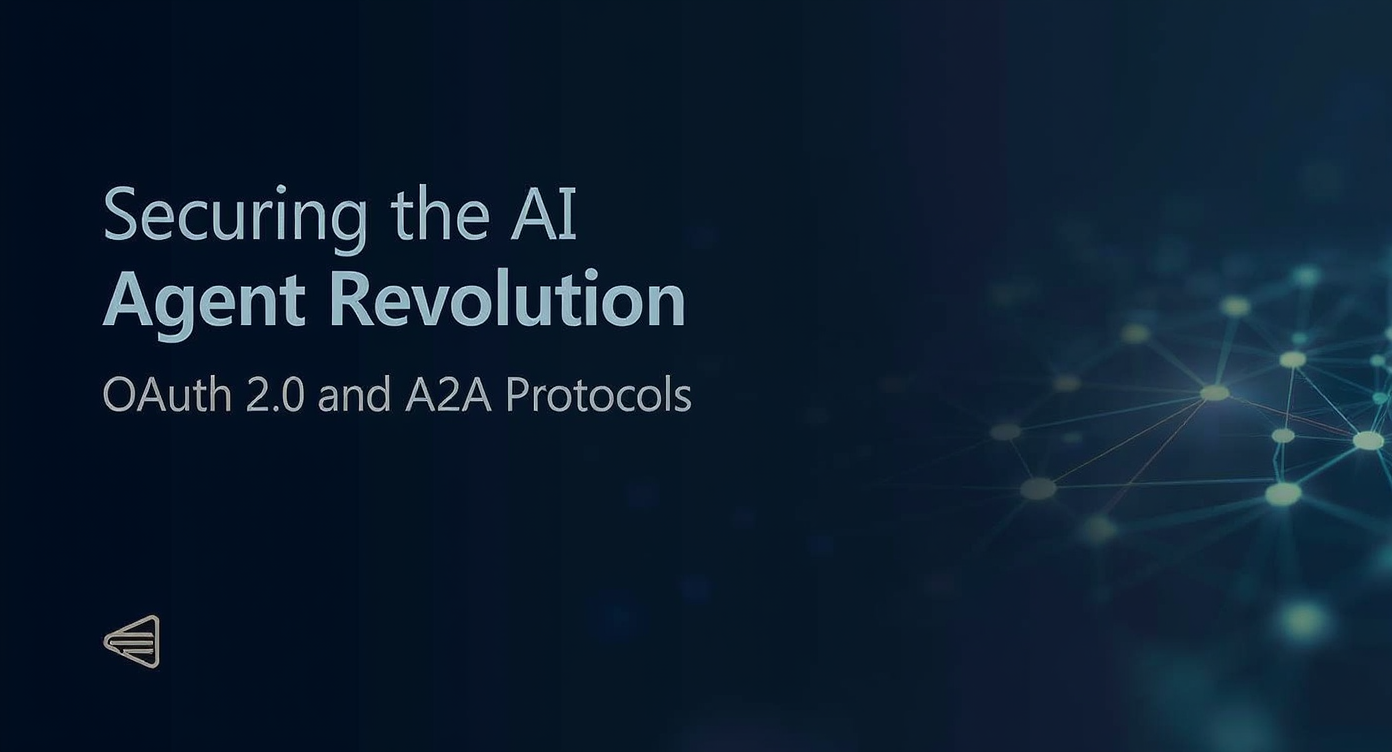| 🌐 Read this post in: English | Español | Deutsch |
📄 Read the complete report: OAuth for AI Agent Integration - Comprehensive guide on securing AI agents with OAuth 2.0 and A2A protocols.
As autonomous AI agents transform from experimental technology to enterprise reality, traditional security frameworks face their biggest test yet. Here’s how forward-thinking organizations are adapting OAuth and emerging protocols to secure the multi-agent future.
The New Security Frontier
The enterprise technology landscape is experiencing a seismic shift. Autonomous AI agents—entities capable of reasoning, planning, and acting independently—are rapidly moving beyond simple chatbots to become sophisticated digital workers. These agents don’t just respond to queries; they make decisions, delegate tasks to other agents, and perform complex workflows on behalf of human users.
But with this revolutionary capability comes an unprecedented security challenge: How do you secure entities that think, learn, and act autonomously?
Traditional Identity and Access Management (IAM) systems, built for predictable human users and static machine identities, are struggling to adapt. OAuth 2.0 and SAML—the backbone of modern enterprise security—were never designed for entities that can evolve their behavior, collaborate with peers, and make real-time authorization decisions.
The core challenge: An autonomous AI agent’s identity isn’t just a credential—it’s a dynamic reflection of its capabilities, delegated authority, and real-time context.
Why Traditional Security Models Break Down
The Autonomy Problem
Unlike traditional applications that follow predetermined code paths, autonomous AI agents exhibit true autonomy. They make independent decisions, adapt their behavior based on context, and can even modify their own operational parameters. This fundamental unpredictability breaks the “trust once, trust always” model that underpins most current security architectures.
The Delegation Dilemma
Perhaps more critically, autonomous AI agents frequently act “on behalf of” human users. When your AI assistant books a meeting, transfers funds, or accesses sensitive documents, it’s not just authenticating itself—it’s exercising delegated human authority. This requires a new kind of security primitive: authenticated delegation with cryptographic proof of human authorization.
The Scale Challenge
Modern enterprises are rapidly moving toward multi-agent ecosystems where dozens or hundreds of specialized agents collaborate on complex workflows. Traditional point-to-point authentication simply doesn’t scale when you have agents dynamically discovering, negotiating with, and delegating tasks to other agents across organizational boundaries.
OAuth 2.0: The Unexpected Foundation for AI Security
Despite its age, OAuth 2.0 provides a surprisingly robust foundation for AI agent security—but only when properly adapted and extended.
Machine-to-Machine Gets an AI Upgrade
The OAuth 2.0 Client Credentials flow, originally designed for service-to-service communication, proves ideal for agent authentication. Here’s how the modern approach works:
- Agent Registration: Each AI agent receives unique cryptographic credentials (moving beyond simple passwords to certificate-based authentication)
- Token Request: Agents authenticate using their credentials and request specific, granular permissions (scopes)
- JWT Tokens: The authorization server issues JSON Web Tokens containing both standard claims and AI-specific metadata
- Resource Access: Agents use these tokens to access protected resources with full auditability
The Art of AI-Specific JWT Claims
The real innovation lies in custom JWT claims that capture AI-specific context:
{
"sub": "agent-payment-processor-v2.1",
"agent_type": "PaymentProcessor",
"capabilities": ["process_payment", "refund_transaction", "fraud_check"],
"delegated_user_id": "john.doe@company.com",
"organization_id": "acme-corp",
"policy_version": "v2.3",
"risk_level": "low"
}
This rich metadata enables resource servers to make sophisticated authorization decisions based not just on who the agent is, but what it can do, who authorized it, and under what conditions.
Security Best Practices for the AI Era
Short-Lived Everything: Access tokens expire in 5-15 minutes, forcing regular re-authentication and allowing for real-time policy updates.
Zero Shared Secrets: Advanced implementations use asymmetric cryptography (Private Key JWTs, mTLS) instead of shared client secrets, providing stronger security and better auditability.
Granular Scopes: Instead of broad “admin” permissions, agents receive precisely scoped access like financial-data:read-only or user-calendar:schedule-meetings.
Enter the A2A Protocol: Building the Agent Internet
While OAuth handles agent-to-service authentication, the emerging Agent2Agent (A2A) Protocol tackles the even more complex challenge of agent-to-agent communication.
Agent Cards: The Business Card for AI
A2A introduces “Agent Cards”—standardized JSON documents that agents expose to advertise their capabilities and security requirements. Think of them as sophisticated business cards that enable dynamic trust establishment:
{
"agent_id": "logistics-optimizer-v3",
"capabilities": ["route_optimization", "inventory_management"],
"authentication_methods": ["oauth2", "mtls"],
"security_level": "enterprise",
"supported_protocols": ["json-rpc-2.0", "websocket"]
}
OAuth + A2A: A Perfect Partnership
The genius of A2A lies in its OAuth compatibility. Rather than inventing new authentication schemes, A2A explicitly supports OAuth 2.0, creating a seamless integration path for organizations with existing identity infrastructure.
When Agent A wants to delegate a task to Agent B:
- Agent A discovers Agent B via its Agent Card
- Agent A uses its OAuth token to authenticate with Agent B
- Agent B validates the token and determines authorized actions
- Secure JSON-RPC communication begins over HTTPS
- All interactions are logged for full auditability
Advanced Patterns for Enterprise Scale
Dynamic Client Registration: Automated Onboarding
As agent ecosystems grow, manually registering each agent becomes impractical. Dynamic Client Registration (DCR) allows agents to self-register with the authorization server, complete with automated credential issuance and policy assignment.
Token Exchange: The Art of Delegation
OAuth 2.0 Token Exchange (RFC 8693) enables sophisticated delegation scenarios. An agent with broad permissions can exchange its token for a more restricted one when delegating to another agent, implementing perfect “least privilege” principles.
Application-Layer Security: Defense in Depth
For highly sensitive operations, organizations are implementing message-level encryption (JWE) and signing (JWS) on top of TLS, ensuring end-to-end security even across complex agent networks.
Real-World Challenges and Solutions
The Human-Agent Trust Bridge
One of the biggest challenges is translating human natural language instructions into machine-executable security policies. Organizations are implementing “human-in-the-loop” approval systems where users review and explicitly approve AI-generated policies before agents receive authorization.
Continuous Trust in Dynamic Systems
Unlike static applications, autonomous AI agents can modify their behavior over time, learning and adapting based on new contexts. This fundamental dynamism breaks traditional security assumptions and demands a shift to “never trust, always verify” principles. Organizations must move from “authenticate once” to “continuously validate” models, implementing real-time monitoring and ML-based anomaly detection to flag unusual agent behavior patterns.
The On-Device Agent Problem
As AI agents move to edge devices and user endpoints, traditional network-centric OAuth flows become less applicable. This is driving innovation in local authorization frameworks and device-native security primitives.
The Architecture Decision: Centralized vs. Distributed
Organizations face a critical choice in authorization architecture:
Centralized Approach: A single authorization service manages all policies and decisions. Benefits: consistency and simplified management. Risks: single point of failure and latency.
Distributed Approach: Each service manages its own authorization. Benefits: resilience and performance. Risks: policy inconsistency and complexity.
Hybrid Model (Recommended): API Gateway handles initial authentication, while specialized policy engines manage complex authorization decisions. This provides the best balance of performance, consistency, and resilience.
The Road Ahead: Future-Proofing AI Security
Emerging Standards to Watch
- SD-JWT for Agent Cards: Selective disclosure capabilities for privacy-preserving agent discovery
- OAuth 3.0 Evolution: Next-generation authorization framework designed with AI agents in mind
- W3C Agent Governance Standards: Emerging frameworks for autonomous system accountability
Implementation Roadmap
- Phase 1: Implement OAuth 2.0 Client Credentials for basic agent authentication
- Phase 2: Deploy Dynamic Client Registration for scale
- Phase 3: Integrate A2A Protocol for agent-to-agent communication
- Phase 4: Add Token Exchange for advanced delegation scenarios
- Phase 5: Implement application-layer security for sensitive operations
Conclusion: Securing the Autonomous Future
The integration of OAuth 2.0 with AI agents and the A2A Protocol isn’t just a technical evolution—it’s a fundamental reimagining of enterprise security for the autonomous age. Organizations that proactively adapt their identity infrastructure will gain a significant competitive advantage, enabling secure, scalable, and auditable AI agent ecosystems.
The future belongs to those who can balance the incredible potential of autonomous AI with the imperative of security, trust, and accountability. With the right architectural choices, established OAuth foundations, and emerging protocols like A2A, that future is not just possible—it’s within reach.
Key Takeaways:
- AI agents require dynamic, context-aware identity management beyond traditional IAM
- OAuth 2.0 provides a strong foundation when properly extended with AI-specific patterns
- The A2A Protocol enables secure, scalable agent-to-agent communication
- Success requires balancing autonomy with security, using granular permissions and continuous validation
- Organizations should start with foundational OAuth patterns and gradually adopt advanced features
Ready to dive deeper into the technical implementation details?
📥 Download the Complete Technical Report: “Integrating OAuth with AI Agents and the A2A Protocol for Secure Authentication and Authorization”
A comprehensive 7,200-word guide with detailed architectural diagrams, implementation strategies, security best practices, and advanced patterns for enterprise autonomous AI agent security.
About the Author: Sebastian Schkudlara is a software architect with over 19 years of experience in software development, specializing in secure, scalable AI systems and modern enterprise identity frameworks.
 Sebastian Schkudlara
Sebastian Schkudlara

 🌐 AI Agent Protocols: The Enduring Foundation for Developers in 2025
🌐 AI Agent Protocols: The Enduring Foundation for Developers in 2025
